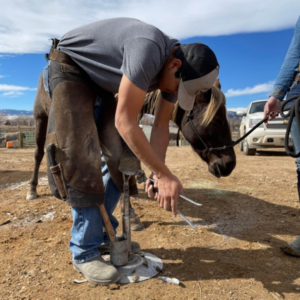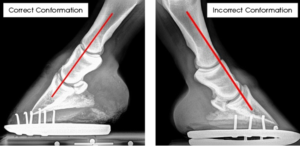Written by: Susan Chandler, CHR Lead Trainer | Edited by: Tauren Feuerstein, Marketing Associate
As equine enthusiasts, owning a horse is one of the most fulfilling privileges we can experience. With all the pleasure horses can bring us, owning them is a great responsibility and requires guardians to ensure their horses are set up for happy and healthy lives.

It is an owner’s responsibility to provide for their horses’ basic needs such as access to shelter, quality nutrition, maintaining mental wellness, and managing overall health. Likewise, it is imperative that your horse has consistent, quality farrier care. Hooves are an essential component of a horse’s well-being which, when improperly managed, can lead to long-term and often irreversible damage.
To better understand our domesticated horses’ feet, we can look to their wild counterparts. Wild horses don’t have the luxury of farrier visits and humans regularly trimming their hooves. Instead, these horses often travel 10 to 20 miles daily over diverse terrain in search for food and water which naturally files down their feet. Additionally, wild horses have been bred for survival through natural selection, and they genetically tend to have stronger hooves than domestic horses.
In contrast, many domesticated herds today don’t need to trek miles a day to have their basic needs met, and instead are contained in smaller and softer spaces with controlled diets and exercise. As a result, the domestic horse’s hoof structure has evolved to accommodate their domestic environments by becoming softer and needing farrier care to remove excess length and reshape the hoof. Moreover, inappropriate breeding geared towards aesthetics rather than sound structure has also contributed to chronic hoof issues in many horse breeds that exist today. Thus, the responsibility has shifted over time from the horse to its human handlers to maintain adequate hoof health over the horse’s lifespan.
Like most other aspects of equine care, a horse’s hoof management routine will vary depending on the horse. Many factors impact the health of our horses’ feet, and the cause of a hoof-related issue is rarely as clear-cut as having untrimmed hooves versus not. We know that when the foot is appropriately balanced, the delicate internal structures are less likely to see damage. This makes it essential that responsible horse owners work regularly with a farrier (a typical cycle is about 6 to 8 weeks) who has a history of maintaining healthy feet and understands how to help horses recover from, and prevent, various hoof problems. Unfortunately, it only takes one minor, uncalculated change to negatively impact a horse’s soundness, making it all-the-more important to choose your farrier wisely.

Looking at the hoof-pastern axis can help both farriers and horse owners determine if the foot is healthy and balanced. Ideally, the bone structure in the lower leg runs down in a straight line from the pastern to the toe (left image). This helps eliminate unwanted stress upon the foot framework. Alternatively, when the bones are bending backward to support the leg tendons and other supporting structures on the back of the hoof and leg become strained, leading to arthritic damage and pain (right image). One primary example of improperly managed feet we frequently see at Colorado Horse Rescue is long toes with underrun heels. This imbalanced hoof conformation often leads to internal damage which can cause irreversible, chronic conditions such as navicular disease. Chronic hoof conditions can become extremely costly to manage and ultimately lead to severe pain resulting in long-term loss of function. As responsible horse owners, we are obligated to prevent improper or negligent hoof care from being the cause of chronic pain for our amazing animals.
For some horses, hoof trimmings alone aren’t enough to keep them sound and pain-free and horseshoes (or “shoes”) become necessary. Shoes are generally helpful in adding an extra barrier to our horses’ feet. This can be beneficial for horses living and/or working in rough terrain which wears the hoof down more quickly and can lead to tender feet and bruises in the horse’s sole. Horses who are competitive athletes can also benefit from wearing shoes due to the increased stability and improved traction shoes provide. For horses who already have a chronic hoof disease, shoes with supplemental (or “therapeutic”) pads can provide added protection from the ground and soften pressure on their frogs, soles, and toes.
This collective knowledge gives credence to the common quote: “No hoof, no horse.” Horses rely heavily on their legs and feet to do what their humans ask of them. Unfortunately, when these areas are neglected, even the most cooperative horse can become unwilling to work due to discomfort and pain. It is imperative that we as horse owners take our horses’ hoof care seriously for the entirety of their lives. Providing consistent, balanced hoof care that honors a horse’s age and stage helps support their overall quality of life and can prevent them from developing potentially painful conditions. It’s a privilege and a duty to care for our horses, and together we proudly make up the network of support that keep our horses healthy and strong from head to hoof!